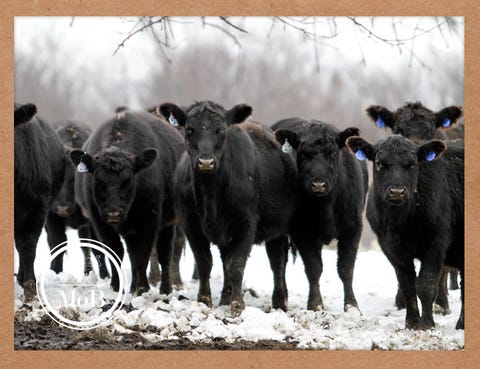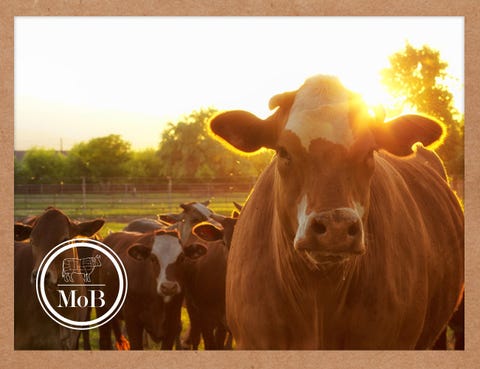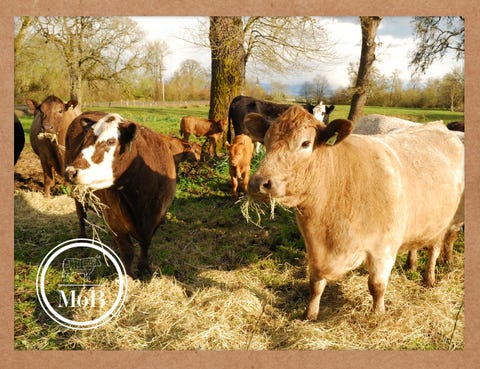How Big Do Short Legged Black Angus Cattle Get

We've given you a beef baptism in buying beef online, the rules of store-bought beef, beef's lesser-known cuts and even beef you can drink. Kicking things up a notch (BAM!), let's explore the breeds of cattle that end up on your plate — putting a face on things, so to speak.
Get your breed on (not that kind, you pervert) after the break.

Breeds of cattle are all variants of the Bos taurus species in the same way a German Shepherd is different from a Labrador Retriever, but still a dog. The biggest question that comes to mind: does the breed make much difference in the beef you buy, or is this all a marketing attempt to make a silk purse from a cow's ear? The short answer is yes, though there is certainly marketing and animal husbandry involved. The next question we'll answer? Where can you buy it? We introduced you to 10 mail order meat companies earlier, and that's a good place to start — but we'll get to specifics here.
Black Angus

Angus, and more specifically Black Angus, is the most prevalent beef-producing breed in the U.S., with numbers greater than the next seven breeds combined. Some of this is the result of history — Scottish Angus stock was the first cross-bred with the exclusively longhorn herds brought over by the Spanish. Though the polled, or hornless, Angus were initially disdained, the improvement in flavor and tenderness over the tough, lean longhorns made quick converts of cattlemen and their customers.
Their efficiency — the ability to turn grazing into bodyweight — and the low rate of birthing problems (dystocia) made the Angus a quick moneymaker for the ranchers who raised them. Today, the Certified Angus Beef program requires a greater than 50% black face and adherence to 10 quality standards. Furthering their popularity, British cattle tend to have lower shear force values (a measure of tenderness) than continental breeds, though there are exceptions. Paired with an aggressive marketing campaign, being the firstest with the mostest has made Angus beef number one in the U.S. Many butchers and online meat purveyors offer 100% Angus beef.
Herefordshire

Hereford cattle are another British breed, from Herefordshire, England; they're noted for their hardiness and adaptability to a variety of climates. Designated Certified Hereford Beef has a face that's 51% or more white with no white markings on the hip, shoulder or side of the body. Less expensive than Angus, the compact, short-legged Herefords are more efficient then most breeds at converting pasture to prime beef, and this quality along with hardiness is the principal reason they are often cross-bred with other breeds, particularly Angus. Crystal River Meats and DeBragga, two of the online sellers we surveyed, offer Angus-Hereford meats.
Piedmontese

Piedmontese are the Arnold Schwarzeneggers of beef. Originating in the Piedmont region of Northwest Italy, the breed has a distinguishing genetic anomaly called "double muscling". The result of an inactive myostatin gene, the controller of muscle development, double muscling gives Piedmontese cattle less marbling and chemical fat (3.8% vs. 5.6% for Angus) and a higher protein content — essentially a healthier choice for beef lovers. The limitations in USDA grading systems means Piedmont beef is frequently select or lower grade. While you might think this would mean sacrificing tenderness, a University of Georgia study showed no significant difference in shear force values between normal muscle and double-muscle beef. However, because delivering a double-muscled calf often proves difficult for Piedmontese dames due to narrow birth canals relative to calf size, homozygous ("pure-bred) Piedmontese bulls are cross-bred with Angus cows. This gives the added benefit of higher grades. To preserve leanness, a Piedmontese bull may be bred with a Continental variety. Heritage Farms makes Piedmontese beef available in the U.S.
Waguyu

Couched in the mystique borne of rarity, Wagyu is the most oft-misunderstood beef. Language barriers, prohibitions on export (some imposed by Japan, and some by the U.S. due to an outbreak of hoof-and-mouth disease), and rumors of obsessive animal rearing — such as naming each animal (true for some breeders), building appetite with beer (true), and rub-downs by naked virgins (unfortunately, not true — the virgins part, that is) — have further muddled the beefy waters.
Wagyu literally means "Japanese cattle", and comprises four breeds originating from an infusion of Continental, or European, stock (mostly Swiss) created in the early 1900s during the Meiji Restoration. A concerted breeding program post-WWII, whereby geneticists individually select each sire and dame for their genetic compatibility, has led to one of the most refined, homogeneous stock of cattle in the world.
Kryoshi (Japanese Black) and Akaushi (Japanese Red) account for the most coveted beef, and in Japan the Sandai Wagyu ("three big Japanese cattle") are Matsusaka, Kobe, and Yonezama or Omi. Kobe beef, the most well-known breed, is named for the capital of the Hyogo Prefecture. Matsusaka takes Tajima-ushi heifers from Hyogo and coddles them with rich feed augmented with beer and regular massages; all this produces meat especially prized for flavor, tenderness, and fatty marbling. Wagyu is rated on a completely different scale than other breeds — A1 to A5, with A5 the highest — based on marbling intensity, fat color, muscle color and muscle shape. The fat, high in heart-healthy oleic acid, melts at 77 degrees Fahrenheit.
Wagyu is produced in Japan, Australia, and the U.S. The relatively inexpensive grazing land in Australia and the U.S. allows for larger herds that can be sold at lower prices; the majority of Wagyu eaten in Japan comes from outside the country for that very reason. American Wagyu is often cross-bred with Angus or Hereford to gain the efficiency and size of the latter breeds. A few stateside breeders maintain the purity of the lines, and their meat commands a premium in the U.S. Debragga sells Wagyu from Japan, Australia, and America; and Heritage sells the Akaushi (Japanese Red).
In short, breed matters. Marketing will always play a role — a large one — adding just one more reason to always be on your toes when deciding what sort of steer to devour. Share your knowledge (bbqs are a perfect classroom) but remember: don't be a beef showoff. Drop your breed knowledge humbly. Experiment with your steer selections, always pay the right price and, most importantly, enjoy the feast.

This content is created and maintained by a third party, and imported onto this page to help users provide their email addresses. You may be able to find more information about this and similar content at piano.io
How Big Do Short Legged Black Angus Cattle Get
Source: https://www.gearpatrol.com/food/a68264/mob-knowing-beef-cattle-breeds/